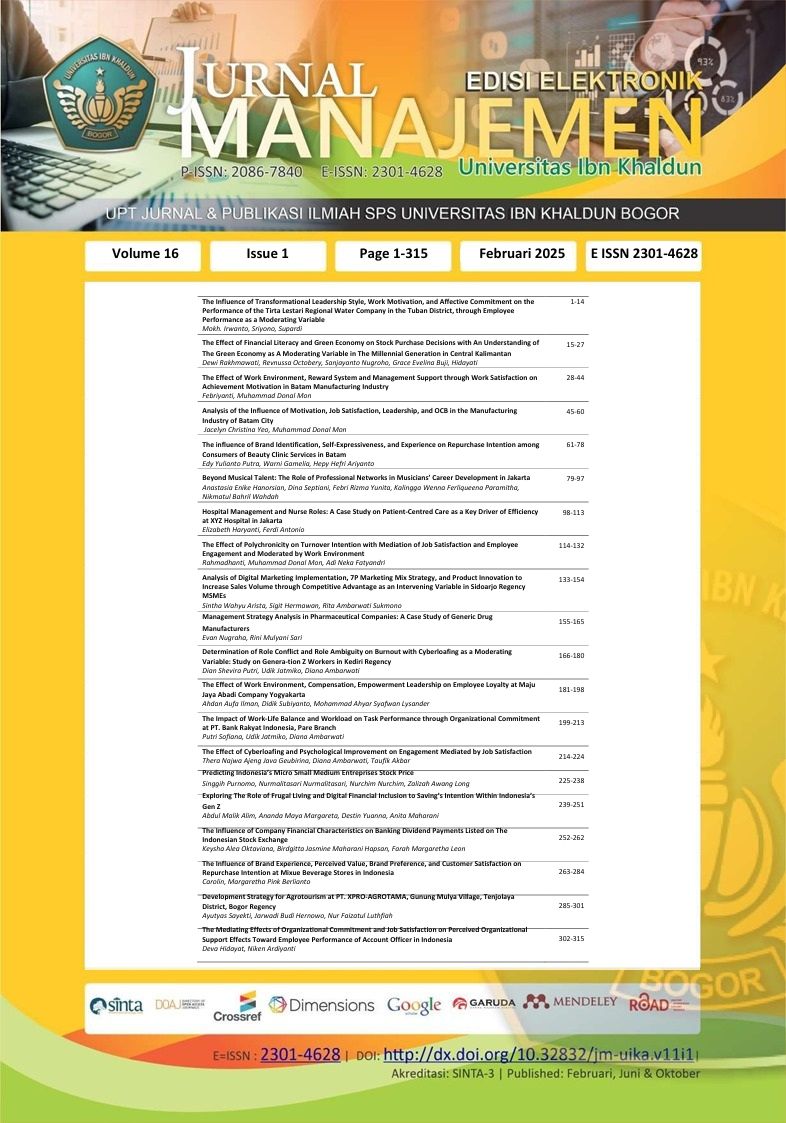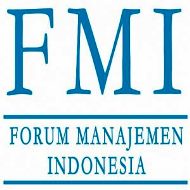The Effect of Cyberloafing and Psychological Improvement on Engagement Mediated by Job Satisfaction
DOI:
https://doi.org/10.32832/jm-uika.v16i1.18307Keywords:
keterkaitan, kerja, perilaku kerja, inovatif, Work EmpowermentAbstract
This research aims to examine how the level of work empowerment among employees at PT Citra Warna Abadi influences their innovative work behavior. The study involved 79 respondents, consisting of both current and former employees of PT Citra Warna Abadi, selected through a non-probability sampling method with a purposive component. Data was collected using a questionnaire in this quantitative research study. Structural Equation Modeling (SEM) with the Partial Least Squares (PLS) method was used to analyze the data, utilizing the SmartPLS version 4.0 application.
The results reveal a positive and statistically significant relationship between job engagement and creative actions at work. Additionally, work empowerment is positively and significantly influenced by employee engagement. When employees feel empowered in their roles, they are more likely to act creatively and independently. Job engagement also impacts innovative work behavior indirectly through work empowerment. This study suggests that PT Citra Warna Abadi can enhance its employees' creative output by improving their job engagement. Therefore, factors like employee engagement, which significantly influence innovative work behavior, should receive greater attention from the company. The findings highlight the importance of work empowerment in fostering a workplace environment conducive to creativity and innovation. Future research could explore the role of other organizational factors, such as workplace culture and leadership, in driving employees’ innovative work behavior.
References
Abidin, R., Abdullah, C. S., Phd, Hasnan, N., & Bajuri, A. L. (2014). University Utara Malaysia (UUM), School of Technology Management and Logistic, 06010. Australian Journal of Basic and Applied Sciences, 8(12), 61–66.
Ardilasari, N., & Firmanto, A. (2017). Hubungan Self Control dengan Perilaku Cyberloafing pada Pegawai Instansi Kota Malang. Jurnal Ilmiah Psikologi Terapan, 05(01), 19–39.
Ary, I. R., & Sriathi, A. A. A. (2019). Pengaruh Self-Efficacy dan Locus of Control Terhadap Kinerja Karyawan. E-Jurnal Manajemen Unud, 8(1), 6990–7013.
Askew, K., Buckner, J. E., Taing, M. U., Ilie, A., Bauer, J. A., & Coovert, M. D. (2014). Explaining cyberloafing: The role of the theory of planned behavior. Computers in Human Behavior, 36, 510–519.
Aziiz, A. (2019). Hubungan antara Self Control dengan Counterproduktive Work Behavior (CWB) pada Perawat. UIN Sunan Ampel Surabaya.
Blanchard, A. L., & Henle, C. A. (2008). Correlates of different forms of cyberloafing: The role of norms and external locus of control. Computers in Human Behavior, 24(3), 1067–1084. https://doi.org/https://doi.org/10.1016/j.chb.2007.03.008
Ghozali, I. (2008). Structural equation modeling: Metode alternatif dengan partial least square (pls). Badan Penerbit Universitas Diponegoro.
Henseler, J., Ringle, C. M., & Sarstedt, M. (2015). A new criterion for assessing discriminant validity in variance-based structural equation modeling. Journal of the Academy of Marketing Science, 43, 115–135.
Jong, J. P. J. (2007). Individual Innovation: The connection between leadership and employees’ innovative work behavior. EIM Amsterdam, The Netherlands:
JUMANTORO, R., FARIDA, U., & SANTOSO, A. (2019). Pengaruh Kompetensi, Motivasi Kerja, Beban Kerja, Dan Pelatihan Terhadap Produktivitas Kerja Sumber Daya Manusia Koperasi Serba Usaha Anak Mandiri Ponorogo. ISOQUANT : Jurnal Ekonomi, Manajemen Dan Akuntansi, 3(1), 106. https://doi.org/10.24269/iso.v3i1.244
Lin, N. H., Tsay, S. C., Maring, H. B., Yen, M. C., Sheu, G. R., Wang, S. H., Chi, K. H., Chuang, M. T., Ou-Yang, C. F., Fu, J. S., Reid, J. S., Lee, C. Te, Wang, L. C., Wang, J. L., Hsu, C. N., Sayer, A. M., Holben, B. N., Chu, Y. C., Nguyen, X. A., … Liu, G. R. (2013). An overview of regional experiments on biomass burning aerosols and related pollutants in Southeast Asia: From BASE-ASIA and the Dongsha Experiment to 7-SEAS. Atmospheric Environment, 78, 1–19. https://doi.org/10.1016/j.atmosenv.2013.04.066
Nugroho, A. (2022). Kepemimpinan Autentik Dan Perilaku Inovatif: Keterikatan Kerja Sebagai Mediasi. PROCEEDING IAIN Batusangkar, Ncssr, 48–54.
Nurhaini, D. (2018). Pengaruh Konsep Diri dan Kontrol Diri dengan Perilaku Konsumtif dengan Gadget Remaja SMAN 1 Tanah Grogot. ejournal. psikologi. fisip-unmul. ac. id., 6 (1).
NURHAQSARI, W. (2023). PERAN MEDIASI WORK EMPOWERMENT PADA PENGARUH KETERIKATAN KERJA TERHADAP PERILAKU KERJA INOVATIF (Studi Pada PT Citra Warna Abadi). AT-TAWASSUTH: Jurnal Ekonomi Islam, VIII(I), 1–19.
Prawira, A. W. (2017). Hubungan kontrol diri dengan perilaku kerja kontraproduktif pada aparatur sipil negara kota batu. Skripsi. Fakultas Psikologi Universitas Muhammadiyah Malang.
Purnomo, & Pranitasari, D. (2024). The Role of Work Engagement in Mediating Organizational Culture and Self-Efficacy on Commitment at PT. Perusahaan Listrik Negara. Ecoment Global Journal, 9(2), 2024.
Sugiyono. (2020). Metodologi Penelitian Kuantitatif, Kualitatif dan R & D.
Sulistiawan, J., & Andyani, D. (2020). Psychological Contracts, Innovative Work Behavior, and Knowledge Sharing Intention: the Role of Work Engagement and Job Resources. Jurnal Aplikasi Manajemen, 18(4), 741–753. https://doi.org/10.21776/ub.jam.2020.018.04.13
Triyanti, T., Amelia, W., Maharani, A., & Pandu, T. L. S. (2022). Peran Cyberloafing Terhadap Produktivitas Karyawan Dengan Kesehatan Mental Sebagai Pemediasi. Jurnal Manajemen, 13(3), 353. https://doi.org/10.32832/jm-uika.v13i3.7317
Downloads
Published
How to Cite
Issue
Section
License
Copyright (c) 2024 Jurnal Manajemen

This work is licensed under a Creative Commons Attribution-NonCommercial 4.0 International License.
Authors who publish with this journal agree to the following terms:
- Authors retain copyright and grant the journal right of first publication with the work simultaneously licensed under a Creative Commons Attribution-NonCommercial-ShareAlike 4.0 International License that allows others to share the work with an acknowledgement of the work's authorship and initial publication in this journal.
- Authors can enter into separate, additional contractual arrangements for the non-exclusive distribution of the journal's published version of the work (e.g., post it to an institutional repository or publish it in a book), with an acknowledgement of its initial publication in this journal.
- Authors are permitted and encouraged to post their work online (e.g., in institutional repositories or on their website) prior to and during the submission process, as it can lead to productive exchanges, as well as earlier and greater citation of published work (See The Effect of Open Access).











